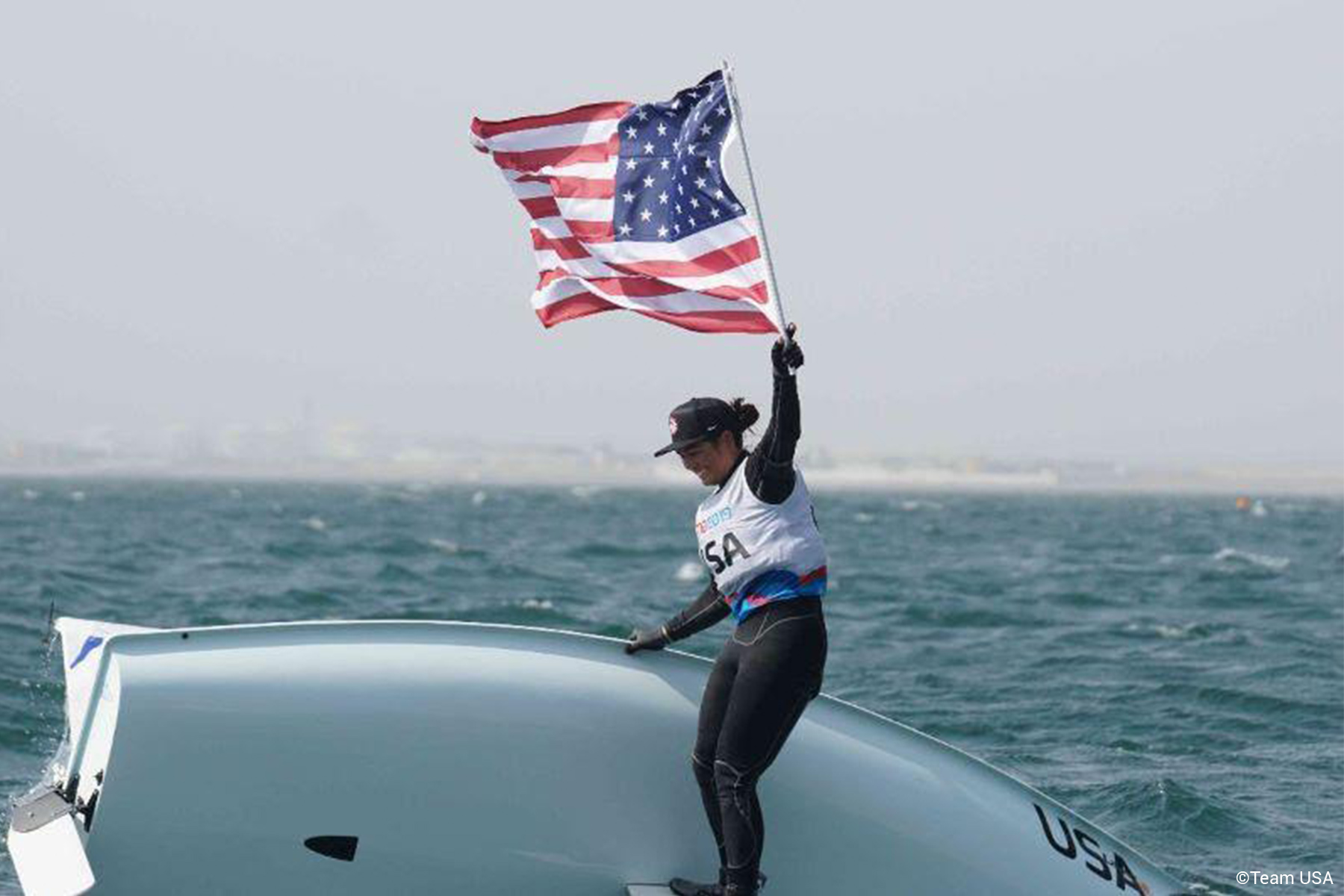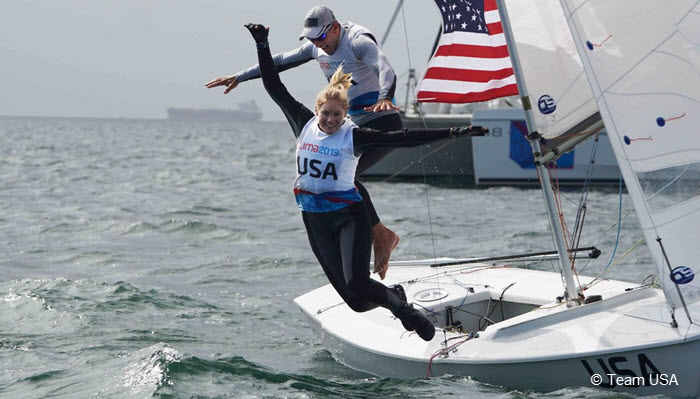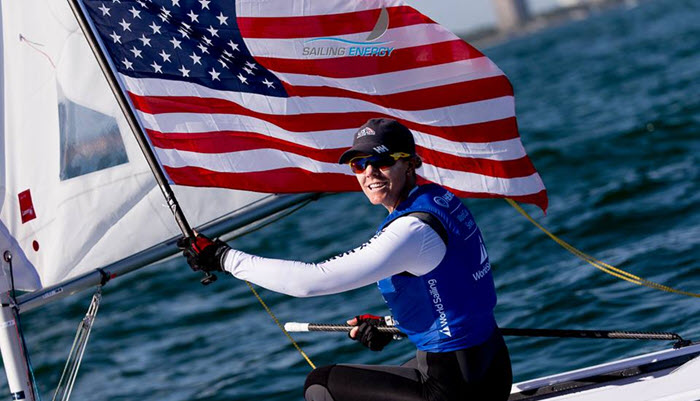
When the Going Gets Tough, the Tough Get Going
By Hannah Feinberg, SPT Dietician, with contributions from SPT Coaches, Mike Kuschner and Fred Strammer
SPT Platinum athlete Charlotte Rose, clinched Silver at the Pan American Games in the Laser Radial. Charlotte’s why: “I enjoy traveling, making new friends, and the rush I get from getting closer and closer toward my goals.”
This summer was a busy month for many of our Olympic athletes vying for country and team qualification berths at the 2020 Olympic Games in Tokyo, Japan. Athletes in all disciplines put many years of hard work on the line and competed in the 2019 World Championships in Sakaiminato, Japan, the Pan American Games in Lima, Peru, and the Olympic Test Event in Enoshima, Japan. For some, everything aligned and they had top-notch performances. For others, they experienced the low many athletes face when they have a disappointing result. Today we want to shed some light into the importance of knowing your “Why” as an athlete, having a long-term perspective, and understanding the sacrifices it takes to put everything on the table for training and competition.
Know Your “Why”
Early morning wake ups, physically demanding workouts, and mentally straining logistics can make it hard to stay focused and engaged with your programming. All too often, athletes start a journey without identifying their why. At the end of their experience, nothing has really come together – and they look back wondering what they were actually doing. Knowing your why is what distinguishes the truly empowered athlete that endure through the best and the worst of times. Your why is a driving force to motivate you. To keep pushing when things get tough. When you know your why, you will maximize intrinsic motivation rather than relying on others to motivate you; adopt an investment mentality instead of a sacrifice mentality; take full responsibility for yourself, training, and competition; and willingly discipline yourself to do what is necessary.
Asking these simple questions is a really good step to figuring out your why:
- WHY do you compete and train for your goal?
- What do you VALUE in competing and training?
- What do you enjoy MOST about working towards and executing your goal?

(SPT Platinum Athlete, Hallie Schiffman, clinched Gold at the Pan American Games in the Snipe.)
The true answer to the questions above is not as important as the reflection in attempting to answer them. What you, your teammate(s), or the athletes you coach are trying to get with these answers is awareness and acknowledgement of the why. With a solid understanding of the why, one can have perspective on the context of what just happened in the moment to the bigger picture of the goal and better manage the more difficult moments that will inevitably arise. Each athlete’s why is different, therefore we suggest digging deep to determine your why. Once you know, write it down as a gentle reminder on your mirror, a sticky note on your computer, as the title of your alarm clock, or on the piece of gym equipment you despise.
Here are some examples of an athlete’s why:
- I want to be better at [improving specific skill(s)] .
- I want to achieve something that hasn’t been done before.
- I want to push myself and find my limit.
- I want to honor someone special.
- I want to prove my knowledge and experience.
- I want to feel more competent.
- This is my livelihood.
- I want to be the best version of myself.
When I was training for my second Ironman triathlon, my why was raising money to fund research for the disease Friedreich’s Ataxia (FA), a rare and incurable degenerative neuromuscular disorder that two of my best friends have. Whenever my motivation was lacking, I reminded myself how fortunate I was to have two legs that worked to allow me to do the sport that I love and inspire others to donate to find a cure for FA.
Can you see how one’s why creates one’s perception of success, achievement, and even progress? This can be exasperating when you are a part of a team, where everyone’s whys are potentially different. Great coaches know that having a team why is also important: the common goal every teammate can embrace that defines the team’s success, achievement, and progress.What is your why? What is your team’s why?
SPT Collegiate Team, St. Mary’s College Of Maryland Varsity Sailing, shares their why.
Long-Term Perspective
In sailing, athletes don’t peak until their late 20’s and early 30’s. This is because sailing is an endurance sport that takes many years to develop your cardio-pulmonary system, gain muscular endurance, and learn all the required sport-skill. It’s important to remember this, especially when competition doesn’t seem to go your way.
Many of the athletes we work with who sail in the Optimist class or are part of the Olympic Development Program train with the intention of success many years later. The majority of our athletes have started a multi-year (or decade) campaign for the 2024, 2028, and 2032 Olympics. Of course, there are many peaks on the journey towards the long-term goal, which is why SPT Coaches specialize in periodization to maximize long-term athlete development. With this perspective and understanding of multi-year programming, it’s okay (and expected) to have off days or weeks every now and then. Nobody enjoys a disappointing result but it is important to reflect on training, nutrition, sleep, stress, motivation, and other lifestyle factors in the build-up to an event and one’s executing during the competition. Then, gently remind oneself that neither one amazing result nor one terrible result doesn’t necessarily change one’s trajectory as an athlete on a multi-year time frame.
Many times the competitor’s, coach’s, parent’s, and perhaps the media’s perception of a training session, a competition, or how the journey is progressing are very different.
Examples:
Coach: “It was so good to see everyone giving their all and cheering everyone on at the competition – you should be proud of your efforts.”
Athlete: “That was horrible, I sucked in that race, I was anxious the whole time – it was painful.”
Coach: “You really did not have it all together out there – guess we have to go back and look at the basics.”
Athlete: “That was so awesome – the conditions, the competition – I had a ton of fun!”
Athlete after a drill: “That didn’t feel good at all, I just couldn’t execute that one maneuver the exact way I should have – I feel way behind.”
Same athlete after reviewing camera footage of drill: “Overall, it actually looks a lot better than it felt, perhaps I am not that far off.”
These are obvious misalignments between what the coach and athlete are thinking, are understanding as the why, or bias’ in perception in the moment vs after the fact.

(SPT athlete Paige Railey.)
Recently Paige opened up about her illness and how that influences her why:
“I hope to inspire people out there with diseases, syndromes, and any setbacks in life to go after dreams and not let it hold them back… I want to show that we can do what everyone else can.”
How Sailing Performance Training Can Help
- Discourage early specialization: It’s not healthy physically or mentally to train specifically for sailing year round – even for the top Olympic athletes. We encourage an off season to try something new and continue to develop the tools needed for long-term athlete development. [Learn more about Early Specialization]
- Monthly consults with your coach: The SPT Coaches are here to help you! For some athletes, they need to talk through or be reminded of their why with their coach, especially after a disappointing result.
- Periodized training: Using 5 phases of training, the SPT can help get you in peak shape for your long-term and short-term events. Long-term planning helps to set smart goals and stay focused on athlete’s why.


